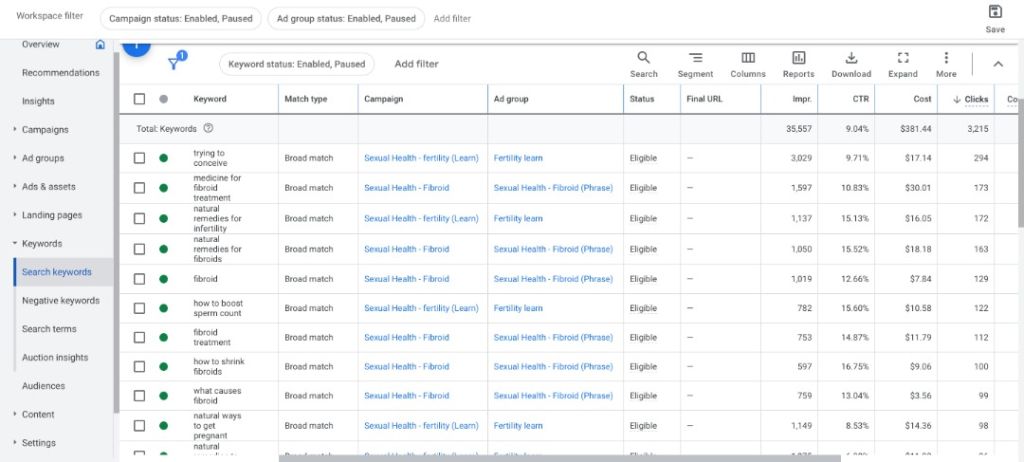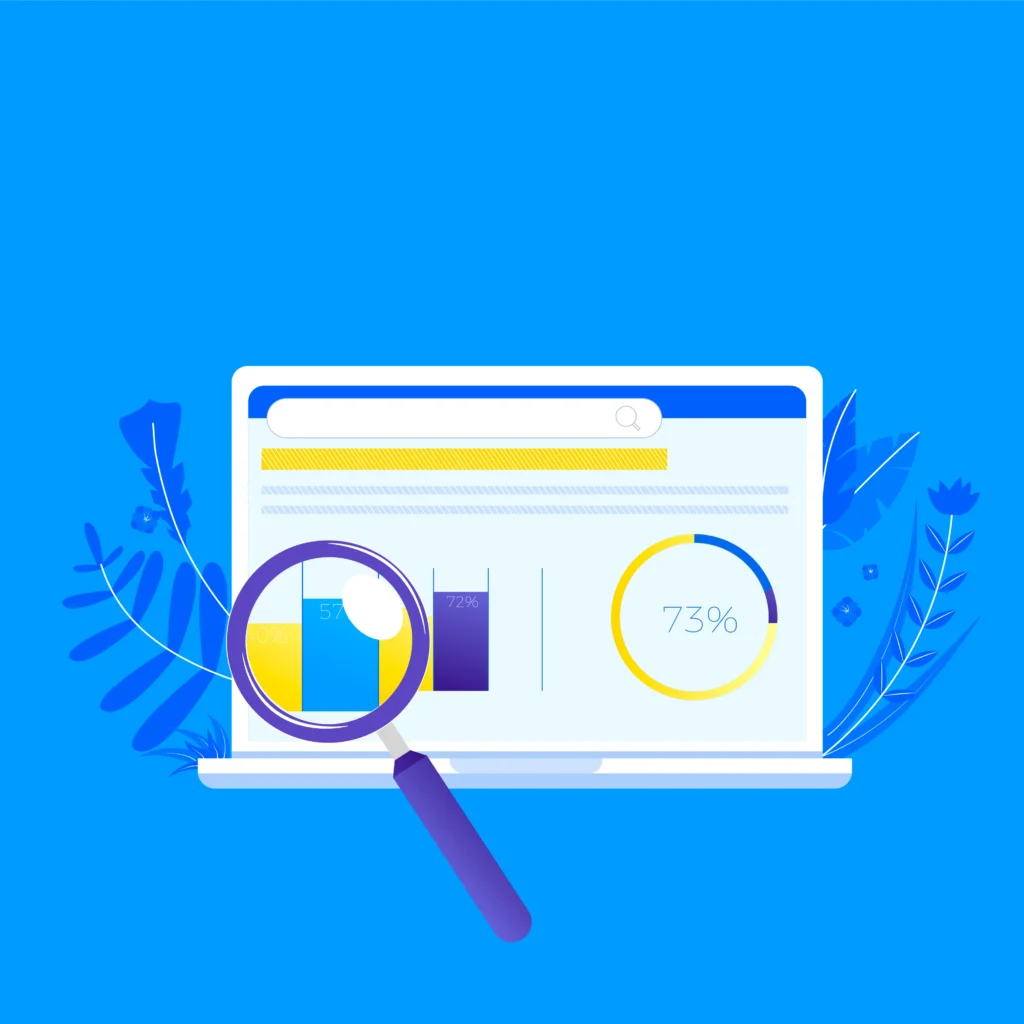Sonni Health is a health brand that provides pure natural and organic products to people with no side effects.
The goal of marketing was to create awareness and drive traffic to their website. In the end, they wanted us to drive sales or conversions on their website.
For every client, the first thing we do is to run an initial audit to assess the business, and the strategy we would need to use based on what we find through the audit.
So from the audit, we came up with these findings;
- The website was poorly organized
- Website was not optimized for search engines.
- Bad landing page experience(speed, images)
- The website had no sitemap
- Website content was not search engine friendly
Website
The client already had a website but had not established any authority due to poor landing page experience and bad SEO practices. So we advised that the client allows for a complete rebuild of their website to improve the navigation of the homepage and make it easy for potential customers to find any information they needed.
The rebuild also gave us the opportunity to make it SEO-friendly, which we’ll discuss further in the SEO section.
A poorly navigable website usually increases the bounce rate of your website. The bounce rate reflects the time visitors spend before they leave. If your website is poorly structured, visitors won’t stay for long.
So we restructured and redesigned the website, to make it easily navigable and accessible. We made sure information was readily available for potential clients.
We also added a WhatsApp chat button on the website to make it simple for potential clients to ask pertinent questions without having to fill out a form and wait for an email reply.
SEO
For SEO, the client didn’t have the experience or the expertise to ensure his site was SEO-friendly. SEO stands for Search Engine Optimization, and it involves all the processes that are undertaken to improve a website’s rank in Search engine results. According to Google, most users don’t go past the 2nd page of the Search Engine Results Pages(SERPs). With this in mind, it is therefore important that your website ranks within the first 3 pages to even be visible to most users.
Because the client already had a website and had published some articles, we tweaked a number of things to improve the SEO:
Landing Page Experience
We optimized all images on the website to help improve the page load times. After we were done, the page load was 2X what it was previously. Because landing page experience is very crucial in organic ranking, it was important to implement all measures that would make the average user or visitor have an easy time going through the website.
As mentioned earlier, we restructured how information was displayed, reduced the clutter on the homepage, and we advised the client to provide high-quality media, which we optimized for use on the website.
Keywords
The most important factor to consider when improving SEO is noting keywords that describe the industry of the website owner. These keywords are words that search users type when searching for a business or service. When you have figured out these keywords, you use them to come up with various helpful articles, thereby establishing your authority in the industry.
On-page SEO
Blog Articles
For the pre-existing articles, we edited each article, setting focus keywords for each of them based on the central idea of the articles, and adhering to some important SEO guidelines. In all, the website has 148 blog articles

For SEO here are some of the things we did, per article to make sure it is SEO-friendly and that they would appear on SERPs:
- We made sure each article has a focus keyword, which serves not only as the central idea of the article but also helps to trigger our articles when search users type any of our focus keywords in their search query. We also ensured this focus keyword is present on at least 1% of the entire article ie. present in the title, description, and the first few words of the article. For Google, websites are triggered based on how prominent the searcher’s search terms are on each website page. The more prominent a search term is in an article, the greater the likelihood of the article ranking high.
- We added sub-titles throughout the article, with each having an underlying concept or idea. This makes the article easy to read for readers.
- We added internal links. Adding internal links (or Interlinking) presents you the opportunity to link other articles or pages of your website in the blog article. This means that readers can jump into other articles straight from the current one they’re reading. This method can help generate some traffic for interlinked pages or articles.
- We also added external links. With this, you’re including links from other websites in your articles. It could be from the same industry or another, but it should be related to the article you’re writing. This would help establish your authority in your field of operation.
- We ensured all images had Alt-texts. It is very common for people to just upload media or images to their blog articles, without adding alt text. Alt text is a text that briefly describes what the image is about or explicitly what is being shown in the image(usually for screen readers). In the context of SEO, the images you upload should have alt text as this make . This alt text should ideally contain the focus keyword of the article.
Technical SEO
This is a type of Search engine optimization that is done behind the scenes, in the backend of the website. So what we did was:
- Add an XML Sitemap. An XML sitemap is a file that catalogues a website’s key pages so that Google can identify and crawl them all. It also helps search engines understand the structure of websites. The XML sitemap will make it easier for search engines to index your content. The client had a number of pages that were not indexed in the beginning so it was important to take this step.
- We used an SSL. Secure Sockets Layer (SSL) is a security technology that creates an encrypted link between a web server and a browser. You can spot a site using SSL fairly easily: the website URL starts with ‘https://’ rather than ‘http://.’
- We made the client’s website more responsive. More than 50% of internet users visit websites using mobile cell phones rather than traditional desktop or laptop computers. As more and more people move to mobile phones, these records have only increased with time. You should make every effort as an online business owner to seize and profit from this opportunity.
- We registered the website on Google Search Console. When we were ready to launch the website, we submitted the XML sitemap we created to the Google Search Console, which allowed us to gain insight into how our pages were doing on Google Search, and what keywords we could adopt in a PPC campaign as well as focus keywords for articles.
SEO Results
SEO is so valuable and a must-adopt for all businesses online because it is free. Even though it would take time before huge results start manifesting, it is worth it in the end. This is because you don’t have to pay to rank high in most SERPs. All it takes is dedication, and the numbers will start increasing.
In all, we created and edited a total of 148 blog articles that satisfied all basic SEO guidelines over the course of 12 months. In that span, our client gained a total of 6.4K impressions.

The website also ranked in the 1st to 3rd pages of organic Google SERPs (Search Engine Result Pages). Given that SEO is a long-term project, and ranking anywhere between the 1st to 10th page of Google SERPs could take between 18 to 24 months, this result is particularly impressive.
PPC Ads (Google Ad Campaign)
Strategy
We also ran a Google Ads Search campaign for the client. We created 8 different campaigns based on the structure of the clients’ ecommerce. They had different categories of products (e,g Fibroid, high blood pressure, prostate products, etc). So we used these categories to create separate campaigns for each of them. This would allow us to create specific ads and keywords for each of these, and not have a situation where client’s ads would pop up for queries that had no relation with the ads.
We did an A/B Split testing between “Maximize Clicks” and “Target CPA” (which are both bid strategies) to determine what would work best for each category. In the end, for campaigns that were primarily to raise awareness, we went with “Maximize Clicks”, and for campaigns that were created to drive sales, we went with “Target CPA” to maximize conversions.
Ad Groups
For each of these campaigns, we created 9 different ad groups based on the products under each category. This would allow us to further narrow and focus on each of the products in detail and create specific ads that will speak to the audience in search of these products.
Keyword Planning
We began with keyword analysis, noting down words that are important in their line of work. We also looked at the high vs low competing words in the field and tried to strike a balance based on the client’s budget.
With the Google Keyword Planner and other keyword tools, we funneled and narrowed down the keywords, and ended up with over 180 keywords across all ad groups.
Ads Creation
We needed to create ads for each ad group. We developed 21 responsive text ads in total, focusing on the quality score of each of them. The quality score is an important factor Google looks at in ranking your ads. With a good quality score, you can bid lower for ads than competitors for a particular keyword and still outrank them on the SERP.
Only ads with a high enough Ad Rank may appear. The factors that go into determining Ad Rank include your bid, ad quality, the thresholds for Ad Rank, the context of the user’s search, and the anticipated effects of extensions and other ad formats.
Quality score
Quality Score is Google’s 1-10 rating of the quality and relevance of both your keywords and PPC ads. It is used to determine your cost per click (CPC) and multiplied by your maximum bid to determine your ad rank in the ad auction process. Factors involved in Quality score are:
- Your expected click-through rate (CTR).
- The relevance of each keyword to its ad group(Ad Relevance).
- Landing page experience.
Every ad goes through the ad auction each time it is qualified to show up for a search. The outcome of the auction decides whether or not the ad appears and where on the page it will appear.
The ads we created included relevant keywords that made up both the headings and descriptions. We created responsive ads for each ad group. Each ad contained ad extensions the following extensions to improve the quality score of the ads and also help potential clients have important information just a click away:
- Sitelink
- Callout
- Call-only
- Location extensions
Return on Investment(ROI)
The return on investment on this campaign was measured at 610% or a ratio of 1:6. Return on investment is what returns you gain out of your ads and product listings compared to how much you’ve spent on them. To calculate ROI, take the revenue that resulted from your ads and listings, subtract your cost of goods to get your net profit, and then divide by your overall ad spend: ROI = (Revenue – Cost of services) / Ad spend x 100
How we Measured
When clients are not forthcoming with net profit numbers, ROI estimates can become difficult. We, therefore, rely on ad revenue rather than profits, which most clients are generally happy to share.
Therefore, we utilized the revenue as stated by the customer and divided it by the overall cost of the ads to determine ROI for this client:
ROI = (Revenue) / Cost of ads x 100
This client spent a total of $960 on ads. His products cost at least the equivalent of $115 per unit
Out of a total of 441 leads generated, he sold 51 units thereby generating a total revenue of $5865.
This, therefore, sets the ROI at 610%, or at a ratio of 1:6, which is a very impressive ROI.
If you’re looking to start a digital marketing campaign but want a competent manager, Digital Reach Consult houses the best of the best Digital marketing managers in the world. Do not hesitate to give us a call or send us an email.









